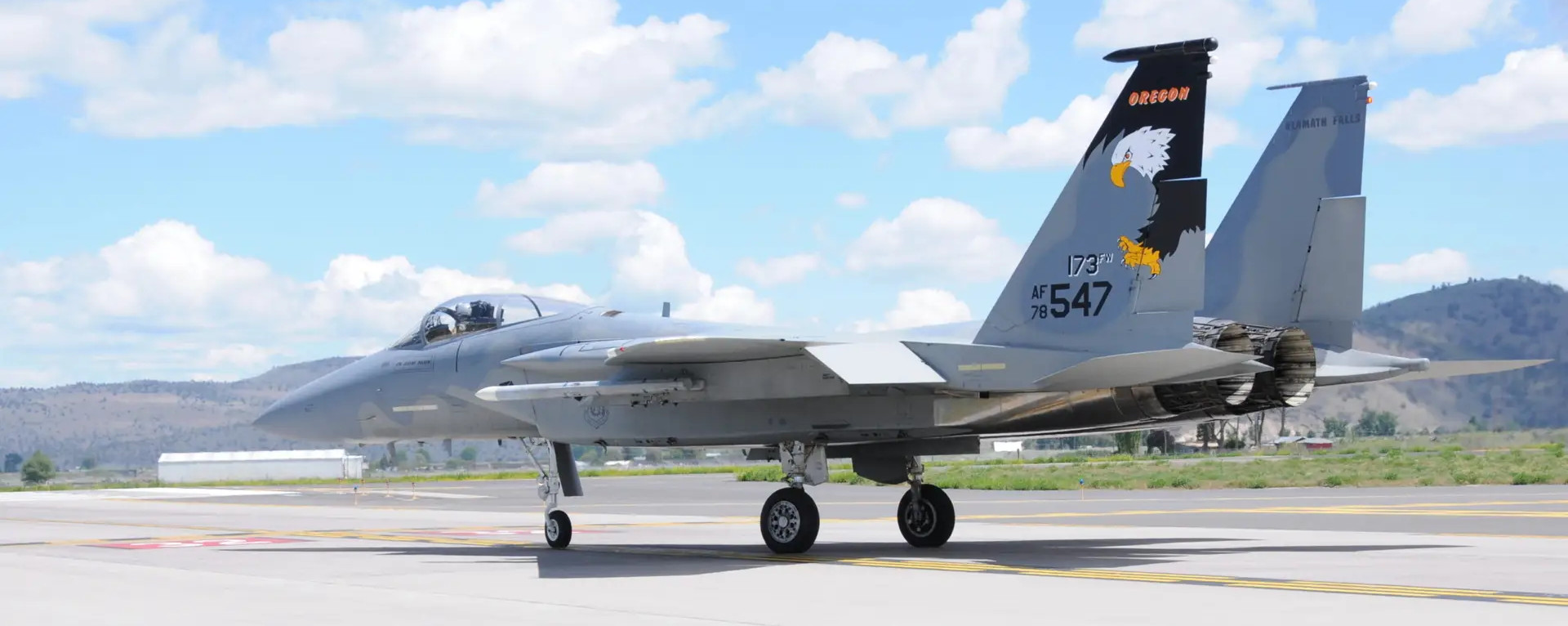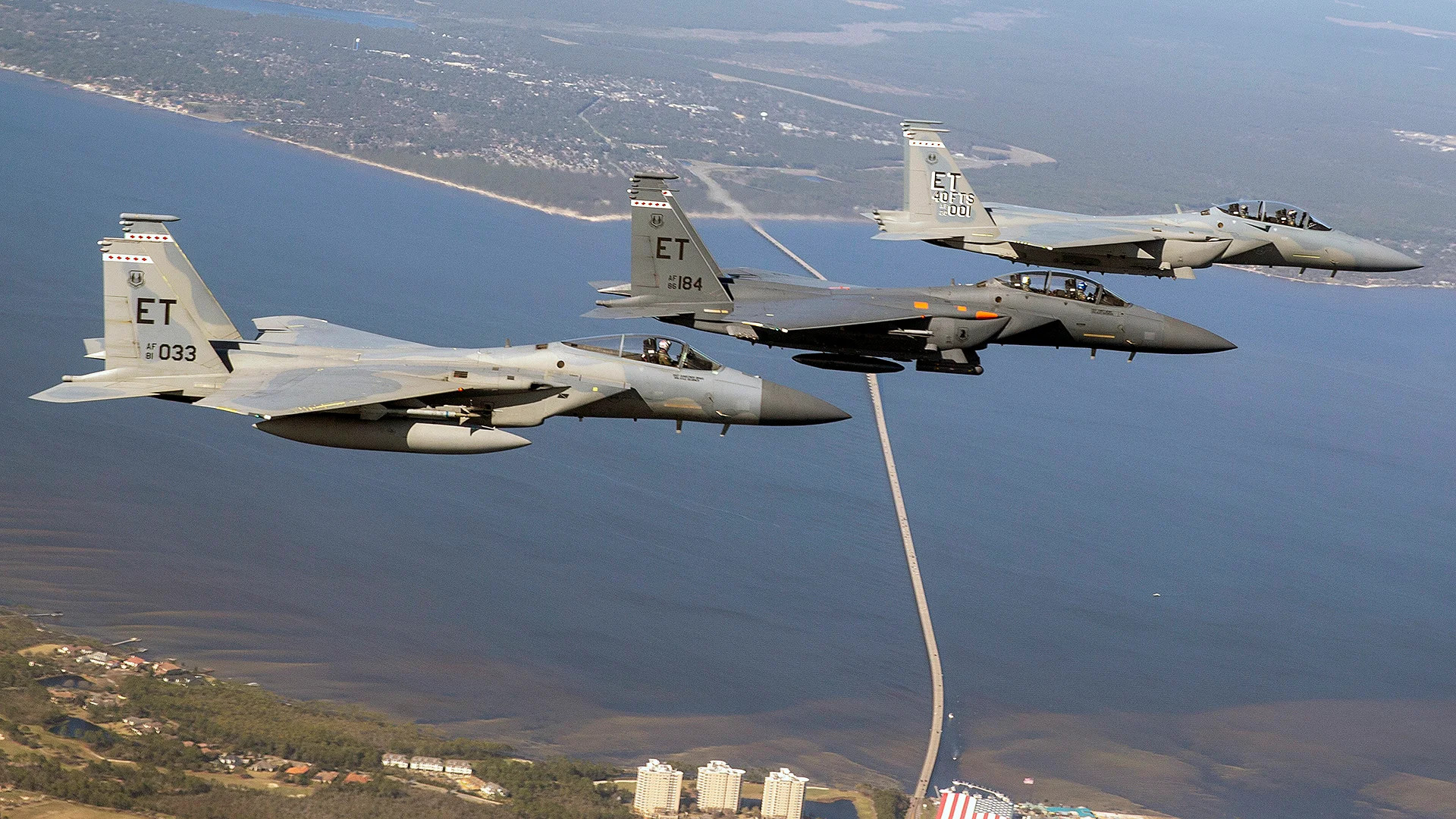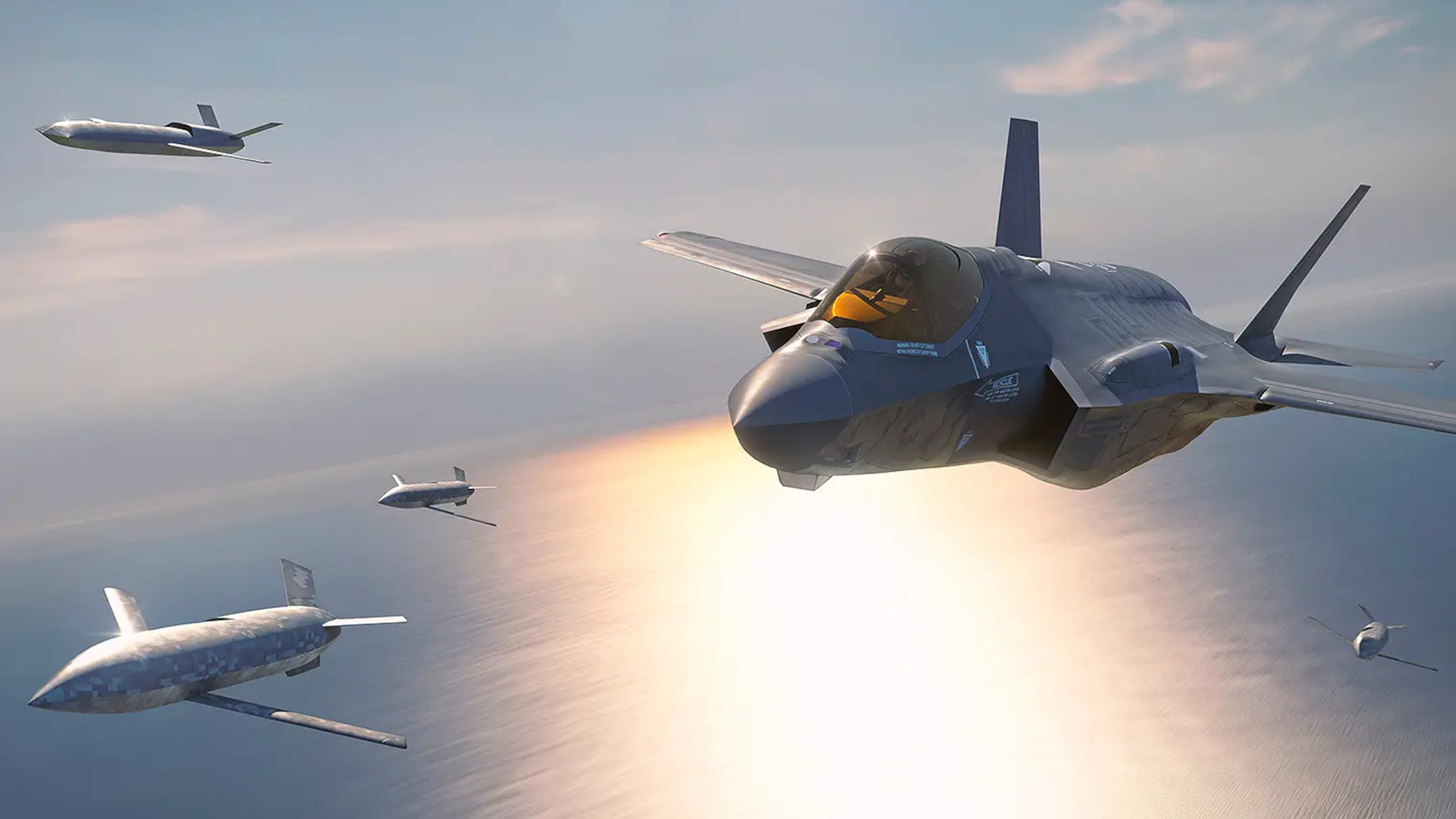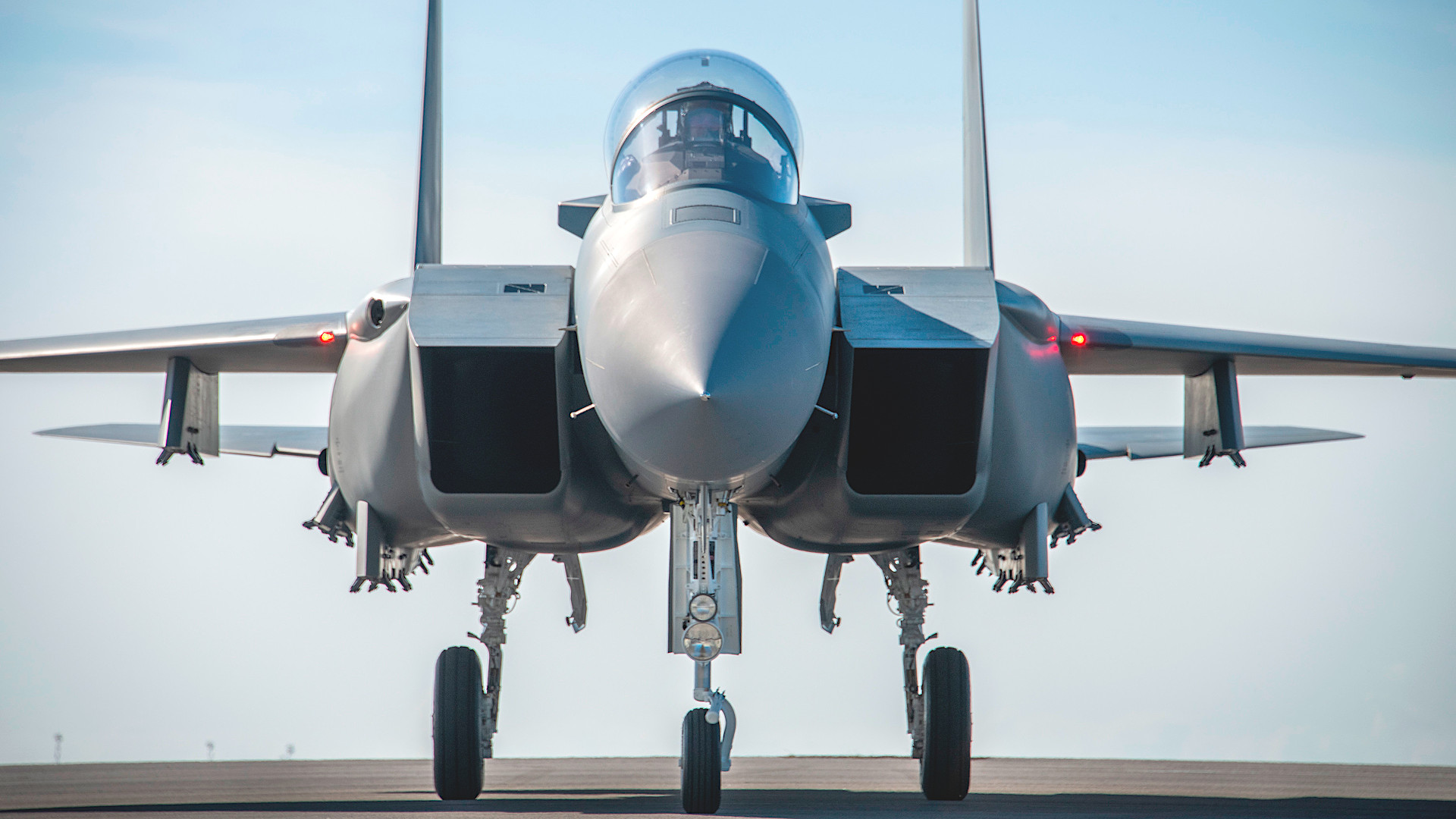The U.S. Air Force is looking to begin buying conformal fuel tanks for its future F-15EX Eagle II fighter jets. Budget documents also confirm that the service plans to ask for funds to acquire another 24 F-15EXs in the 2025 Fiscal Year. This is on top of the two dozen it wants to buy in its latest budget request for Fiscal Year 2024 and is now the last planned purchase of Eagle IIs.
The War Zone did a deep dive questioning the USAF’s F-15EX fleet plan prior to the 2023 budget release that you can read here.
Conformal fuel tanks (CFT) have been part of the F-15’s story going back to its early years and are standard issue on Strike Eagle variants. They have been presented as a core feature of the F-15EX since this newest variant of the Eagle family first emerged in 2018. However, it had become known just this January that the Air Force was not planning to fit its initial tranche of Eagle IIs with CFTs through the most recent annual report from the Pentagon’s Office of the Director of Test and Evaluation, or DOT&E.

“The FY 2024 budget [request] provides funding for 24 F-15EX aircraft and associated support equipment, training systems, depot activation, initial spares, production nonrecurring engineering and related items required to manufacture the aircraft, operational conversion (from F-15C/D to F-15EX) support, logistics and sustainment activities, and program support to manage and execute F-15EX efforts,” according to Air Force budget documentation. “The FY24 budget also includes funding to begin conformal fuel tank (CFT) procurement.”
In total, the Air Force is seeking just over $2.934 million in F-15EX-related procurement funding in the upcoming 2024 Fiscal Year.
The budget documents do not indicate any changes from the existing plan that would see the first F-15EXs initially enter operational service without new CFTs. It’s not immediately clear how many of these tanks the Air Force is looking to buy in its latest proposed budget or when it expects to take delivery of them. The pair of Eagle II test jets the service has now, the only two anywhere in its inventory at present, are notably both fitted with CFTs. We have been told by two sources that the sets of tanks already existed in the inventory, although we have not confirmed this with the USAF.
As The War Zone noted when first covering the CFT issue earlier this year, the decision to not procure the tanks could have impacts on the F-15EX’s capabilities when employed in air-to-air roles, as they are expected to be used primarily, at least initially. The report DOT&E released back in January also highlighted how a lack of CFTs, which also add a number of additional hardpoints for munitions and other stories, would limit the ability of the F-15EXs to perform in a secondary air-to-ground capacity.

The Air Force and the F-15EX’s manufacturer Boeing have been touting the Eagle II’s significant additional range over older F-15C/D Eagles as a major selling point for years now. Range, broadly, has been a central topic of discussion within the Air Force, as well as other branches of the U.S. military, with regard to future tactical aviation plans. The prospect of a future large-scale conflict across broad swaths of the Pacific region, such as one against China, has been a major driving factor.
“The F-15EX program as funded from FY20-FY23 [Fiscal Year 2020 to Fiscal Year 2023] is a direct replacement for the F-15C/D in the air-to-air and homeland defense role,” U.S. Air Force Maj. Alli Stormer, a service spokesperson, told The War Zone in a statement after our initial report. “The F-15C/D does not typically operate with CFTs, and the first operational F-15EX aircraft do not have CFTs funded.”
CFTs negatively impact performance, both in terms of agility and speed/acceleration. Unlikely similar draggy underwing drop tanks, they cannot be rapidly jettisoned to get that performance back if necessary. For the homeland defense role, where there is typically good access to aerial refueling tanker support, the conformal tanks are not necessarily seen as being worth the tradeoff, especially for more localized missions. All this has been pointed out previously by The War Zone, as well as a more detailed look at how CFTs impact performance and increase other capability areas for the Eagle, which you can read in full here.

The penalty that comes with the CFTs in the air-to-air mission set is a reality that has been adapted to more recently by F-15Es employed on air-to-air missions outside the United States. Strike Eagles, which are also typically fitted with CFTs, have been helping fill the gap left by the departure of older F-15C/D air superiority-focused Eagles from RAF Lakenheath in the United Kingdom recently by conducting air patrols without their conformal fuel tanks.
At the same time, there is a precedent for F-15C/Ds being fitted with CFTs in the past to help extend the reach of their sorties, especially in more remote areas where tanker support might be more limited and patrol areas are expansive. Toward the twilight of the Cold War, and immediately afterward, Eagles with these tanks flew from bases in Alaska and Iceland. California Air National Guard F-15C/Ds continue to train to bolster existing homeland defense assets in Alaska, one place where that added range could still be useful. So, acquiring some number of CFTs to at least be available to future F-15EX-equipped units makes good sense. This is especially true for intercept missions where a high degree of performance isn’t necessarily needed, but extended range and operational independence is.

Exactly how many CFTs the Air Force wants to buy and how it will distribute them among F-15EX units remains to be seen and will, of course, be determined in part by the final total Eagle II fleet size. The service’s plans for the jets, overall, have been in flux and while its vision now seems to be increasingly solidifying, important questions do still remain.
As noted at the start of this piece, The War Zone recently did a deep dive into possible options for the F-15EX’s future, as well as questioning the miserly buy of only 80 aircraft, that we published prior to any 2023 budget announcements, which you can read here.
Last year, the Air Force said that wanted to truncate its planned purchases of F-15EXs down from a minimum of 144 to only 80. Ahead of the formal rollout of the 2024 Fiscal Year budget, Secretary of the Air Force Frank Kendall told The War Zone and other outlets at a press briefing that the request for funds for 24 additional aircraft would therefore bring that figure to 104. An additional purchase of 24 more jets in the 2025 Fiscal Year should then bring the total to 128, providing for at least one additional Eagle II squadron.
While this may sound promising, the Air Force’s detailed budget documents, portions of which are seen below, now indicate that the planned F-15EX purchase through its main procurement account will total just 94 jets. This figure apparently includes the two dozen more the service wants to acquire in Fiscal Year 2025, as well as eight Eagle IIs funded through other line items in past budgets.


There is clearly a relatively massive discrepancy here. The War Zone has reached out for further clarification about the total number of F-15EXs the Air Force is currently targeting.
This can only create new uncertainty about what the Air Force’s overall plans for the F-15EX currently are. A fleet of 104 jets would be more or less enough to recapitalize the five remaining F-15C/D units across the Air National Guard (ANG). The California, Oregon, Louisiana, and Massachusetts ANGs each have a squadron of Eagles, primarily tasked with homeland air defense missions, including the highly important job of guarding the ocean approaches to the lower 48 states on both the East and West coasts. The Oregon ANG also has a schoolhouse squadron that provides a training pipeline for these aircraft.
As already noted, the Air Force has shuttered active duty F-15C/D operations in the United Kingdom. It has done the same at Kadena Air Base in Japan. The Air Force decided to replace the Eagles that were at RAF Lakenheath with F-35A Joint Strike Fighters, but, right now, there are no plans for permanent replacements at Kadena. Rotating deployments of fighters, including F-22 Raptors and other types, are currently filling the gap there, at least to a degree.
Between 2020 and 2021, the official plan was for the Oregon ANG’s 142nd Fighter Wing to be the first equipped with F-15EXs, starting this year, followed by the 173rd Fighter Wing, which hosts the schoolhouse unit in the state. The schedule for the 142nd getting its Eagle IIs has since slipped by two years and the plans for the 173rd, which is based at Oregon’s Kingsley Field in Klamath Falls, are now in flux, according to a report just last week from Sandboxx News.

“Several agencies are scheduled to visit in the next few months to gather information that will help determine the Department of the Air Force’s decision regarding what mission will be best suited for the 173rd Fighter Wing,” a spokesperson for the service told that outlet.
“The discussions that I’ve heard, it’s all focused on priorities,” Air Force Senior Master Sgt. Jennifer Shirar, a spokesperson for the 173rd specifically, also said, according to Sandboxx. “Is putting the training base at Kingsley Field the right priority for us, or can we be better filled to do something else… We have a great team here that the Air Force definitely is recognizing as something that they can leverage for whatever mission they need.”
While Shirar would not apparently say what alternatives might be under consideration, she “acknowledged rumors that changing plans might place F-35s” with the unit instead, according to that report.
This is interesting in light of the decision already made to replace F-15C/Ds within the Florida Air National Guard with F-35A Joint Strike Fighters. That course of action remains puzzling given the expectation that the bulk of the ANG’s Eagles still appear to be in line to be replaced by F-15EXs.

In addition, ahead of the budget rollout, Secretary Kendall acknowledged that the Air Force’s current plans did not include enough F-15EXs to affect a one-for-one replacement of all of the F-15C/Ds being retired, including the jets pulled from the United Kingdom and Japan. He then said that the current expectation was that F-35As would supplant the balance of those older Eagles.
The possibility that the Air Force could shutter the F-15 schoolhouse within the 173rd Fighter Wing, but retain the operational squadron within the 142nd Fighter Wing seems odd on the face of it, as well. There would have been certain synergies having the 142nd and the 173rd operate the same type under the Oregon Air National Guard. This, in turn, raises questions about potential links between the still-evolving F-15EX plans and decisions about the future of its F-15E Strike Eagle fleet.
In our reporting on still unconfirmed news that the Air Force could cleave its F-15E fleet roughly in half before the end of the decade, The War Zone pointed out that doing so could leave the service with two relatively niche F-15 communities with roughly 100 jets each. This in turn could present training and logistic issues, such as the costs of having to support two separate schoolhouses for two small fleets of similar aircraft. In our larger expose questioning the future of the F-15EX force, we explored how having a schoolhouse for such a small fleet, a the time just 80 F-15EXs, seemed highly inefficient, and that was before news of a potential F-15E fleet cut was known.

The Air Force could be looking now to consolidate the F-15E and F-15EX training to a single schoolhouse. This would provide a single F-15 schoolhouse for the roughly 200 F-15 aircraft still in service, which would make some sense. Even training F-15EX pilots in the F-15E first could make sense. Conversion training from older F-15 variants to the new EX is relatively straightforward, according to Boeing, and basic conversion can be done in a handful of hours potentially at the squadron level.
The Strike Eagle and Eagle II provide “similar capability,” Air Force Gen. Charles Q. Brown, the service’s Chief of Staff, had said during a talk at the annual McAleese Defense Programs Conference last week, according to Air and Space Forces Magazine. The F-15EX is, of course, a more advanced aircraft than the Air Force’s F-15Es, even once the latter jets are upgraded with new radars and defensive systems.
If the Air Force does indeed plan to shutter the 173rd’s F-15 schoolhouse mission, the jets that would’ve gone to the schoolhouse could be used to stand up an additional operational squadron. At the same time, the acquisition plan laid out in the budget raises another possibility, that the service might be looking to trim the final Eagle II fleet size in other directions.
All of this comes as the Air Force is in the midst of a major modernization push that could see hundreds of legacy aircraft retired in the near term. Only a relatively small number of new acquisitions are currently planned as the service says it needs to make room for future capabilities, including a future sixth-generation stealth fighter and advanced Collaborative Combat Aircraft (CCA) drones being developed under the service’s larger Next-Generation Air Dominance (NGAD) program.
Secretary Kendall announced earlier this month that the Air Force is planning around a future force that includes 200 NGAD combat jets and at least 1,000 CCAs. The CCA figure – which Kendall has said could grow dramatically – reflects an expected ratio, at least initially, of two of those drones for each of the NGAD jets, as well as 300 F-35As. So far, there has been no specific mention of those drones working with F-15E/F-15EXs or F-16C/D Viper fighters, the types that form the other pillars of the Air Force’s future tactical aircraft fleet plans.

Congress gets the final say on what the Air Force’s budget, and that of the rest of the military, does and doesn’t include. So more details about its plans for the F-15EX, as well as the F-15E, should emerge in the coming months as the service seeks to publicly justify its spending and force structure plans.
We do know now that the Air Force plans to acquire at least some number of CFTs to go along with the F-15EXs that it is buying, but significant questions remain about how big the Eagle II fleet will be and how those jets will be assigned.
UPDATE 3/21/2023:
The U.S. Air Force has now clarified key details about the F-15EX fleet size number. The 94-jet figure in the Fiscal Year 2024 budget proposal documents does not include eight jets funded elsewhere in past budgets, as well as two more that were funded in Fiscal Year 2022 through an above-threshold reprogramming (ATR) decision.
The combined total, 104, also includes the 25 F-15EX jets that the Air Force plans to request funds to buy in the 2025 Fiscal Year. Those aircraft are not additive to the 104-jet figure.
Contact the author: joe@thedrive.com
